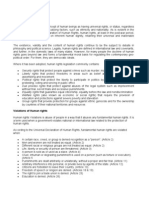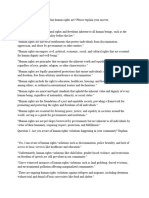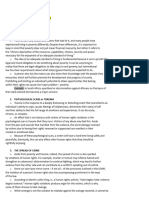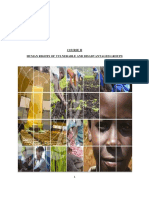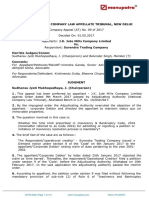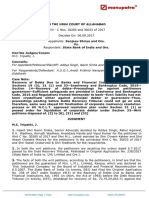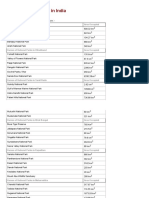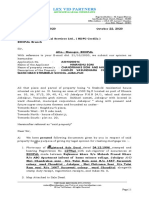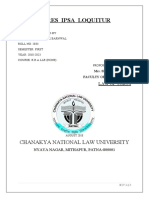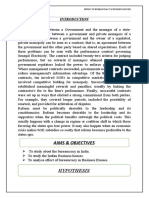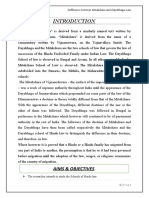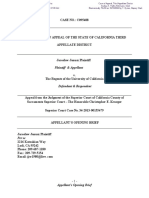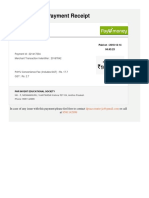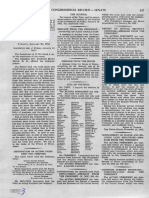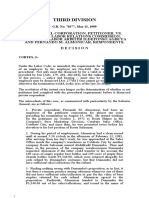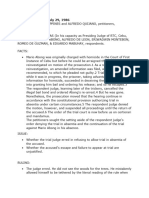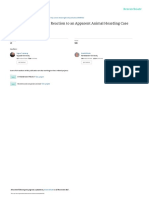CRIMINAL JUSTICE & HUMAN RIGHTS
INSTITUTE OF LAW, RNTU, BHOPAL, MADHYA PRADESH
JUNE 2024
Project Report of
CRIMINAL JUSTICE & HUMAN RIGHTS
On
PROTECTING GROUPS AGAINS HUMAN RIGHTS ABUSES
SUBMITTED BY:
RAJ SHEKHAR
ROLL NO.-R23LA2CS0021
Enroll no.-AU231101
COURSE-LL.M,
1 year, 2nd semester
BRANCH
BRANCH-Criminal and Security Law
SUBMITTED TO:
Dr. NAISH ZAMEER
HOD, Institute of Law, RNTU
1|Page
� CRIMINAL JUSTICE & HUMAN RIGHTS
ABSTRACT
This abstract offers a concise overview of the project focused on protecting organizations against
human rights abuse. It encapsulates the key objectives, methodologies, findings, and implications
of the project.
The project investigates the critical issue of human rights abuse targeting organizations across
various sectors, including governmental bodies, non-governmental organizations (NGOs),
corporate entities, and international organizations. Through a comprehensive analysis, it
examines the multifaceted challenges faced by organizations and identifies strategies for
safeguarding their rights and integrity.
Drawing on empirical research, case studies, and expert insights, the project explores the role of
different types of organizations in protecting against human rights abuse. It delves into
governmental organizations' mandate and effectiveness, NGOs' advocacy and support
mechanisms, corporate entities' corporate social responsibility initiatives, and international
organizations' monitoring and accountability mechanisms.
Furthermore, the project identifies common challenges encountered by organizations in
protecting against human rights abuse, including resource constraints, political pressures, and
legal complexities. It also highlights opportunities for collaboration and synergy among
organizations to enhance human rights protection and promote accountability.
In conclusion, the project underscores the importance of prioritizing human rights protection
within organizations and advocating for robust mechanisms to prevent and address human rights
abuse. By amplifying voices, raising awareness, and fostering partnerships, the project aims to
contribute to a more just and equitable societies where organizations can thrive while upholding
human rights principles and values.
2|Page
� CRIMINAL JUSTICE & HUMAN RIGHTS
TABLE OF CONTENTS
Page no.
1. Introduction……………………………………………………4
2. Understanding Human Rights Abuses…………………………5
3. Different Bodies & Organization against the Human Rights
Abuses………………….…………………………………..…..7
4. Legal Framework For Protection against The Human Rights
Abuses………………………………………………………….9
5. Conclusions ……………..……………………………………12
Plagiarism Certificate………………………………………….
3|Page
� CRIMINAL JUSTICE & HUMAN RIGHTS
INTRODUCTION
In the pursuit of a just and equitable society, the protection of human rights stands as an
imperative pillar. However, despite global efforts and advancements in human rights discourse,
numerous vulnerable groups continue to face systematic discrimination, violence, and
marginalization. This project embarks on a critical exploration of the multifaceted challenges and
strategies in safeguarding these groups against human rights abuses.
Across the globe, vulnerable communities endure the brunt of societal prejudices and
institutional injustices. From ethnic and religious minorities to women and girls, LGBTQ+
individuals, refugees and migrants, and persons with disabilities, systemic barriers impede their
access to fundamental rights and dignity. The persistence of human rights abuses against these
groups not only violates their inherent rights but also undermines the foundational principles of
equality and justice1.
The significance of addressing human rights abuses against vulnerable groups cannot be
overstated. Beyond the immediate impact on individuals, such violations perpetuate cycles of
poverty, inequality, and social unrest, eroding the fabric of cohesive societies. As such, concerted
efforts are needed to dismantle entrenched structures of discrimination and promote inclusive
frameworks that uphold the rights and dignity of all individuals, irrespective of their background
or identity2.
This project aims to shed light on the complex interplay of socio-political dynamics, legal
frameworks, and emerging trends in human rights abuses. Through rigorous analysis and case
studies from diverse regions and contexts, it seeks to uncover the root causes of discrimination
and violence against vulnerable groups, while also identifying strategies for protection and
empowerment.
1
https://www.researchgate.net/publication/236794350_Human_Rights_Protections_for_Vulnerable_and_Disadva
ntaged_Groups_The_Contributions_of_the_UN_Committee_on_Economic_Social_and_Cultural_Rights
2
https://www.humanrights.is/en/human-rights-education-project/human-rights-concepts-ideas-and-fora/the-
human-rights-protection-of-vulnerable-groups
4|Page
� CRIMINAL JUSTICE & HUMAN RIGHTS
By delving into the challenges and opportunities in safeguarding human rights, this project
aspires to contribute to a more informed and conscientious dialogue on the imperative of
protecting groups against human rights abuses. It underscores the collective responsibility of
governments, civil society, and international stakeholders in fostering environments where every
individual can live with dignity, equality, and respect for their rights.
2. UNDERSTANDING THE HUMAN RIGHTS ABUSES
Human rights abuses refer to actions or omissions that violate the fundamental rights and
freedoms inherent to all human beings, as outlined in international human rights law. These
abuses can take various forms and occur in diverse contexts, ranging from systemic violations by
states to interpersonal acts of discrimination and violence. The concept of human rights abuses is
grounded in the recognition of the inherent dignity and worth of every individual, regardless of
factors such as race, ethnicity, gender, religion, nationality, or social status. 3
Here are some key concepts related to human rights abuses:
Violations of Civil and Political Rights: This category includes abuses such as arbitrary
detention, torture, extrajudicial killings, censorship, and restrictions on freedom of expression,
assembly, and association. These violations infringe upon individuals' rights to life, liberty, and
security of person, as well as their rights to participate in political processes and express their
opinions freely.
Violations of Economic, Social, and Cultural Rights: Economic, social, and cultural rights
encompass rights to education, healthcare, housing, food, water, and work, among others.
Human rights abuses in this domain may include inadequate access to essential services,
discrimination in employment, forced evictions, and denial of the right to education or
healthcare.
3
https://www.merriam-webster.com/dictionary/human%20rights%20abuse
5|Page
� CRIMINAL JUSTICE & HUMAN RIGHTS
Discrimination and Marginalization: Discrimination based on race, ethnicity, religion, gender,
sexual orientation, disability, or other factors constitutes a pervasive form of human rights abuse.
It can manifest in various contexts, including employment, education, healthcare, housing, and
access to public services, leading to marginalization and exclusion of certain groups from
opportunities and resources.
Gender-Based Violence: Gender-based violence, including domestic violence, sexual
harassment, rape, and harmful traditional practices, is a significant human rights concern. It
disproportionately affects women and girls and violates their rights to life, dignity, and bodily
integrity.
Violations in Conflict and Crisis Settings: During armed conflict and humanitarian crises, human
rights abuses often escalate, including indiscriminate attacks on civilians, displacement, sexual
violence, and denial of humanitarian assistance. These violations contravene international
humanitarian law and human rights law, leading to widespread suffering and displacement of
populations.
Corporate Abuses: Corporations may also be implicated in human rights abuses, including labor
exploitation, environmental degradation, land grabbing, and complicity in state repression.
Corporate social responsibility frameworks and human rights due diligence processes aim to
mitigate these abuses and hold corporations accountable for their actions.
Understanding the concept of human rights abuses involves recognizing the interconnectedness
of rights and the obligation of states and other actors to respect, protect, and fulfill these rights.
Addressing human rights abuses requires a comprehensive approach that involves legal
frameworks, accountability mechanisms, advocacy, awareness-raising, and empowerment of
affected communities
6|Page
� CRIMINAL JUSTICE & HUMAN RIGHTS
3. DIFFERENT BODIES & ORGANIZATIONS AGAINST THE
HUMAN RIGHTS ABUSES
The protection of human rights abuses involves a multitude of actors at various levels, including
international, regional, national, and local bodies. These entities play distinct but interconnected
roles in monitoring, promoting, and enforcing human rights standards. Here are the primary
bodies responsible for protecting against human rights abuses 4:
1. United Nations (UN) Bodies5:
Office of the High Commissioner for Human Rights (OHCHR): OHCHR leads UN
human rights efforts, provides technical assistance to states, monitors human rights
situations globally, and coordinates international human rights mechanisms.
Human Rights Council (HRC): HRC is an intergovernmental body responsible for
promoting and protecting human rights around the world. It conducts periodic reviews of
human rights situations in UN member states and addresses thematic issues through
resolutions and inquiries.
Special Procedures: Special procedures are independent human rights experts or groups
mandated by HRC to monitor, investigate, and report on specific human rights issues or
countries.
2. Regional Human Rights Bodies:
European Court of Human Rights (ECHR): ECHR adjudicates cases brought against
member states of the Council of Europe alleging violations of the European Convention
on Human Rights.
Inter-American Commission on Human Rights (IACHR): IACHR promotes and
protects human rights in the Americas, monitors human rights situations, and investigates
allegations of violations.
4
https://www.humanrightscareers.com/magazine/international-human-rights-organizations/
5
https://www.un.org/en/our-work/protect-human-rights
7|Page
� CRIMINAL JUSTICE & HUMAN RIGHTS
African Commission on Human and Peoples' Rights (ACHPR): ACHPR promotes
and protects human rights in Africa, monitors compliance with the African Charter on
Human and Peoples' Rights, and receives and investigates complaints.
3. National Human Rights Institutions (NHRIs):
NHRIs are independent bodies established by governments to promote and protect human
rights at the national level. They monitor human rights situations, investigate complaints,
conduct inquiries, and advocate for policy reforms.
Examples include the Australian Human Rights Commission, the Canadian Human
Rights Commission, and the Kenya National Commission on Human Rights.
4. Courts and Judicial Bodies:
National courts play a crucial role in interpreting and enforcing human rights law at the
domestic level. They adjudicate cases involving human rights violations, provide
remedies to victims, and ensure compliance with constitutional and international human
rights standards.
International and regional human rights courts and tribunals, such as the International
Criminal Court (ICC) and the European Court of Human Rights (ECHR), adjudicate
cases involving serious human rights violations and ensure accountability for
perpetrators.
5. Civil Society Organizations (CSOs):
CSOs, including human rights NGOs, grassroots organizations, and advocacy groups,
play a vital role in monitoring human rights situations, documenting abuses, raising
awareness, and advocating for policy reforms and accountability.
6. National Governments and State Actors:
National governments have primary responsibility for protecting human rights within
their territories. They are obligated to respect, protect, and fulfill human rights
8|Page
� CRIMINAL JUSTICE & HUMAN RIGHTS
obligations under international law and to ensure accountability for human rights
violations perpetrated by state actors or non-state actors.
Effective protection against human rights abuses requires collaboration and cooperation among
these diverse actors, as well as active engagement by affected communities and individuals. By
working together, these bodies can promote accountability, uphold the rule of law, and advance
the realization of human rights for all.
4. LEGAL FRAMEWORK FOR PROTECTION AGAINST THE
HUMAN RIGHTS ABUSES
The legal framework for protecting against human rights abuses is comprised of international
human rights instruments, regional treaties, national constitutions, legislation, and judicial
mechanisms. These legal instruments provide a foundation for upholding and promoting
fundamental rights and freedoms, establishing accountability mechanisms, and ensuring redress
for victims of human rights violations6. Here's an overview of the key components of the legal
framework for protecting against human rights abuses:
1. International Human Rights Instruments:
Universal Declaration of Human Rights (UDHR): Adopted by the United Nations
General Assembly in 1948, the UDHR sets out a comprehensive framework of
fundamental human rights, including civil, political, economic, social, and cultural rights.
International Covenant on Civil and Political Rights (ICCPR): This treaty, adopted in
1966, protects civil and political rights such as the right to life, freedom of expression,
and freedom from torture or cruel, inhuman, or degrading treatment or punishment.
International Covenant on Economic, Social and Cultural Rights (ICESCR):
Adopted in 1966, this treaty safeguards economic, social, and cultural rights such as the
right to education, health, work, and an adequate standard of living.
6
https://interagencystandingcommittee.org/sites/default/files/migrated/2014-
11/02%20Gender%20Handbook_Legal%20Framework.pdf
9|Page
� CRIMINAL JUSTICE & HUMAN RIGHTS
Convention against Torture and Other Cruel, Inhuman or Degrading Treatment or
Punishment (CAT): This treaty, adopted in 1984, prohibits torture and other forms of
cruel, inhuman, or degrading treatment or punishment, obligating states parties to
prevent, investigate, and prosecute such acts.
Convention on the Elimination of All Forms of Discrimination against Women
(CEDAW): Adopted in 1979, CEDAW addresses discrimination against women and
requires states parties to take measures to eliminate discrimination in all areas of life.
Convention on the Rights of the Child (CRC): This treaty, adopted in 1989, outlines
the rights of children and requires states parties to ensure the protection and well-being of
children.
2. Regional Human Rights Instruments:
Various regional human rights treaties exist, such as the European Convention on Human
Rights (ECHR), the American Convention on Human Rights (ACHR), and the African
Charter on Human and Peoples' Rights. These instruments establish regional human
rights mechanisms and provide additional protections for individuals within their
respective regions.
3. National Constitutions and Legislation:
Many countries have enshrined human rights protections in their constitutions, providing
a legal framework for the protection of fundamental rights and freedoms.
National legislation further supplements constitutional protections and implements
obligations under international and regional human rights instruments. Laws may address
specific human rights issues, such as discrimination, torture, freedom of speech, and the
rights of marginalized groups.
4. Judicial Mechanisms:
Judicial mechanisms, including national courts and international and regional human
rights courts and tribunals, play a crucial role in interpreting and enforcing human rights
law.
10 | P a g e
� CRIMINAL JUSTICE & HUMAN RIGHTS
Individuals and groups can seek redress for human rights violations through legal
avenues, including filing complaints, seeking injunctions, and pursuing litigation against
perpetrators or state actors responsible for abuses.
5. National Human Rights Institutions (NHRIs):
NHRIs, established in accordance with the Paris Principles, serve as independent bodies
tasked with promoting and protecting human rights at the national level. They play a vital
role in monitoring human rights situations, investigating complaints, conducting
inquiries, and advocating for policy reforms.
6. Civil Society and Advocacy:
Civil society organizations, including human rights NGOs, grassroots groups, and
advocacy coalitions, contribute to human rights protection through awareness-raising,
monitoring, documentation, and advocacy for policy reforms and accountability.
The legal framework for protecting against human rights abuses provides a foundation for
promoting accountability, upholding the rule of law, and ensuring respect for human dignity and
rights. Effective implementation of these legal instruments requires political will, institutional
capacity, and active engagement by states, civil society, and other stakeholders.
11 | P a g e
� CRIMINAL JUSTICE & HUMAN RIGHTS
5. CONCLUSIONS
In conclusion, the protection against human rights abuses is a multifaceted endeavor that requires
the concerted efforts of governments, international organizations, civil society, and individuals.
Throughout history, human rights abuses have persisted in various forms, ranging from
discrimination and violence to systemic injustices and institutionalized oppression. However,
there has also been significant progress in the recognition and protection of human rights, thanks
to the tireless advocacy and activism of countless individuals and organizations worldwide.
Despite these advancements, challenges remain in ensuring effective protection against human
rights abuses. Political interests, economic inequalities, social prejudices, and armed conflicts
continue to fuel violations of fundamental rights and freedoms. Marginalized groups, including
minorities, women, children, LGBTQ+ individuals, refugees, and persons with disabilities, are
disproportionately affected by human rights abuses and face barriers in accessing justice and
redress.
To address these challenges and strengthen protection against human rights abuses, several key
actions are necessary:
1. Strengthen Legal Frameworks: Governments must uphold their obligations under
international human rights law by enacting and enforcing legislation that protects against
discrimination, ensures accountability for perpetrators, and provides remedies for victims.
2. Empower National Human Rights Institutions: National human rights institutions play
a crucial role in monitoring human rights situations, investigating complaints, and
advocating for policy reforms. Governments should support and empower these
institutions to fulfill their mandates effectively.
3. Promote Awareness and Education: Education and awareness-raising initiatives are
essential for promoting a culture of human rights respect and tolerance. By educating
individuals about their rights and responsibilities, societies can challenge discriminatory
attitudes and behaviors and foster respect for diversity.
12 | P a g e
� CRIMINAL JUSTICE & HUMAN RIGHTS
4. Combat Impunity: Impunity for human rights abuses undermines the rule of law and
perpetuates cycles of violence and injustice. States must ensure that perpetrators of
human rights violations are held accountable through fair and impartial investigations and
prosecutions.
5. Support Civil Society: Civil society organizations play a critical role in advocating for
human rights, amplifying the voices of marginalized communities, and holding
governments and other actors accountable. Governments should create an enabling
environment for civil society to operate freely and without fear of reprisal.
6. Promote International Cooperation: Human rights abuses often transcend national
borders, requiring coordinated responses at the international level. States must strengthen
cooperation with international and regional organizations, share best practices, and
support multilateral efforts to address human rights challenges effectively.
In conclusion, protecting against human rights abuses is not only a moral imperative but also a
legal obligation and a cornerstone of sustainable development and peace. By upholding universal
human rights principles and working collaboratively, we can build a more just, inclusive, and
equitable world where the dignity and rights of all individuals are respected and protected.
13 | P a g e










